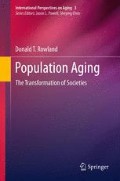Abstract
As countries prepare for the future of aging and the aged a basic question is: How do countries compare in terms of their past and projected experiences of population aging? Prospects of an emerging ‘crisis’ or of ‘business as usual’ are both common in the literature on aging and the future. To test these perspectives and obtain an overview of international trends in aging, Chapter 17 (Risks and Resilience) compares selected countries with reference to the risks they face from population aging and their potential resilience as changes occur. The risk analysis reveals substantial contrasts between groups of countries as well as some marked regional similarities. Resilience is evaluated with reference to economic resources, human capital and public policies. Differences in policies supporting family welfare, which in turn reflect economic, social and cultural variations between countries, are closely associated with levels of risk and resilience. The comparisons in this final chapter provide a summary perspective, showing that societies differ considerably in terms of their likely exposure to population aging and their resources for dealing with it.
The trend towards population ageing is bringing about profound changes for all generations and most areas of economic and social activity. As Europe enters the twenty-first century, the demographic trend towards an ageing society is becoming a highly important issue for social protection, the labour market, politics, design and technology, education and culture, in short for the whole economy and all of society. (Walker 1999)
Access this chapter
Tax calculation will be finalised at checkout
Purchases are for personal use only
References
Cai, Y. (2010). China’s below-replacement fertility: Government policy or socioeconomic development? Population and Development Review, 36(3), 419–440.
CIA. (2010). The world factbook, country comparison: GDP per capita (ppp). https://www.cia.gov/library/publications/the-world-factbook/rankorder/2004rank.html. Accessed Sept 2010.
Marmot, M., & Wilkinson, R. G. (Eds.). (1999). Social determinants of health. Oxford: Oxford University Press.
McDonald, P. (2006). Low fertility and the state: The efficacy of policy. Population and Development Review, 32(3), 485–510.
McDonald, P., & Kippen, R. (2001). Labor supply prospects in 16 developed countries, 2000–2050. Population and Development Review, 27, 1–32.
McDonald, P., & Moyle, H. (2010). Why do English-speaking countries have relatively high fertility? Journal of Population Research, 27(4), 247–273.
OECD. (1998, June). Maintaining prosperity in an ageing society: Summary. Paris: Organisation for Economic Co-operation and Development. http://www.oecd.org/dataoecd/21/10/2430300.pdf. Accessed Sept 2010.
OECD. (2009). StatExtracts. Paris: Organisation for Economic Co-operation and Development. http://stats.oecd.org/lndex.aspx?DataSetCode=DECOMP. Accessed Sept 2010.
OECD. (2010). Factbook 2010: Economic, environmental and social statistics. Paris: Organisation for Economic Co-operation and Development.
Pinnelli, A., Hoffmann-Nowotny, H. J., & Fux, B. (2001). Fertility and new types of households and family formation in Europe (Population studies no. 35). Strasbourg: Council of Europe Publishing.
Population Reference Bureau. (2008). 2008 world population data sheet. Washington, DC: Population Reference Bureau.
Rindfuss, R. R., Guilkey, D. K., Morgan, S. P., & Kravdal, Ø. (2010). Child-care availability and fertility in Norway. Population and Development Review, 36, 725–748.
Swan, W. (2010). Australia to 2050: Future challenges (the 2010 intergenerational report). Canberra: Commonwealth of Australia.
Thévenon, O. (2011). Family policies in OECD countries: A comparative analysis. Population and Development Review, 37(1), 57–87.
Tien, H. Y., et al. (1992). China’s demographic dilemmas. Population Bulletin, 47(1, June), 1–44.
Tobback, B. (2005, October 17–18). Chair’s conclusions. High-level forum on ageing and employment policies, Brussels. www.oecd.org/olderworkersforum. Accessed Apr 2010.
UNESCO. (2005). Education trends in perspective: Analysis of the world education indicators. Paris: UNESCO Institute for Statistics. http://www.uis.unesco.org/TEMPLATE/pdf/wei/WEI2005.pdf. Accessed Sept 2010.
United Nations. (2004). Policy responses to population decline and ageing (Population bulletin of the United Nations, special issue nos. 44/45). New York: United Nations.
United Nations (2009). World population prospects: The 2008 revision population database. New York: Population Division of the Department of Economic and Social Affairs. http://esa.un.org/UNPP/index.asp?panel=2. Accessed Apr 2010.
Walker, A. (1999). Attitudes to population ageing in Europe: A comparison of the 1992 and 1999 Eurobarometer surveys. European Commission: http://ec.europa.eu/public_opinion/archives/ebs/ebs_129_en.pdf. Accessed Feb 2011.
WHO. (2009). Statistical information system. http://www.who.int/whosis/data/Search.jsp. Accessed June 2011.
World Bank. (2011). World development indicators, databank: Central government debt, total (% of GDP). http://data.worldbank.org/indicator/GC.DOD.TOTL.GD.ZS/countries. Accessed Apr 2011.
Author information
Authors and Affiliations
Rights and permissions
Copyright information
© 2012 Springer Netherlands
About this chapter
Cite this chapter
Rowland, D.T. (2012). Risks and Resilience. In: Population Aging. International Perspectives on Aging, vol 3. Springer, Dordrecht. https://doi.org/10.1007/978-94-007-4050-1_17
Download citation
DOI: https://doi.org/10.1007/978-94-007-4050-1_17
Published:
Publisher Name: Springer, Dordrecht
Print ISBN: 978-94-007-4049-5
Online ISBN: 978-94-007-4050-1
eBook Packages: Humanities, Social Sciences and LawSocial Sciences (R0)

